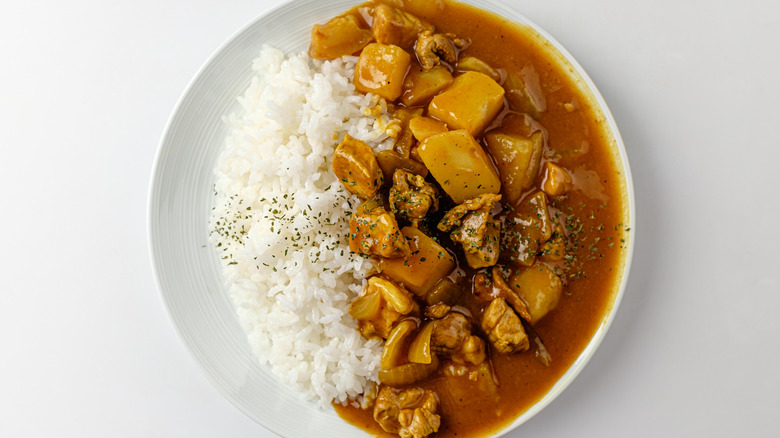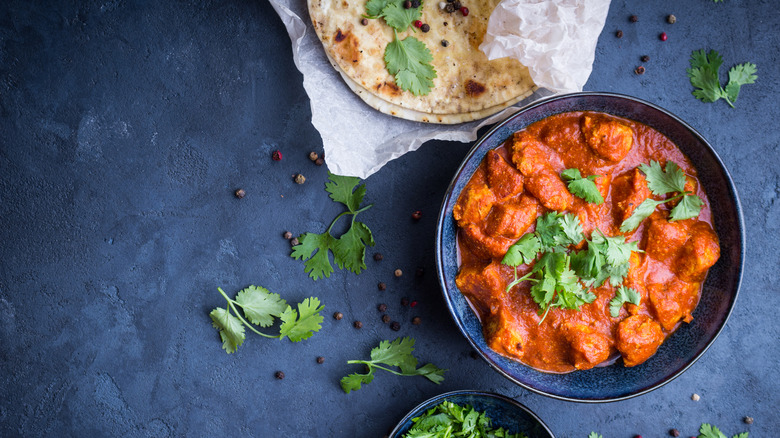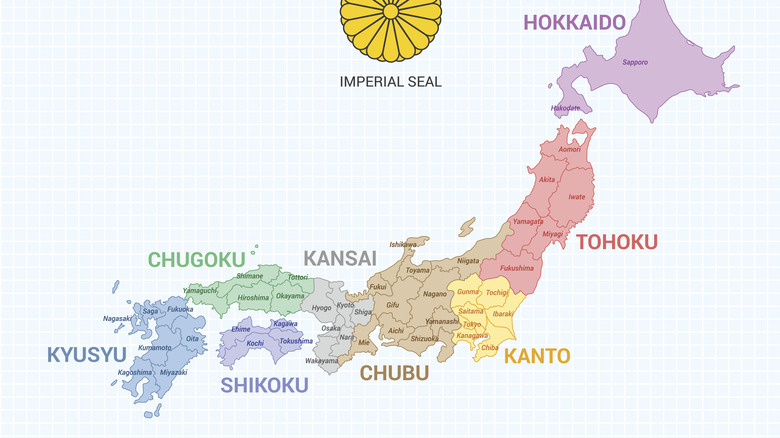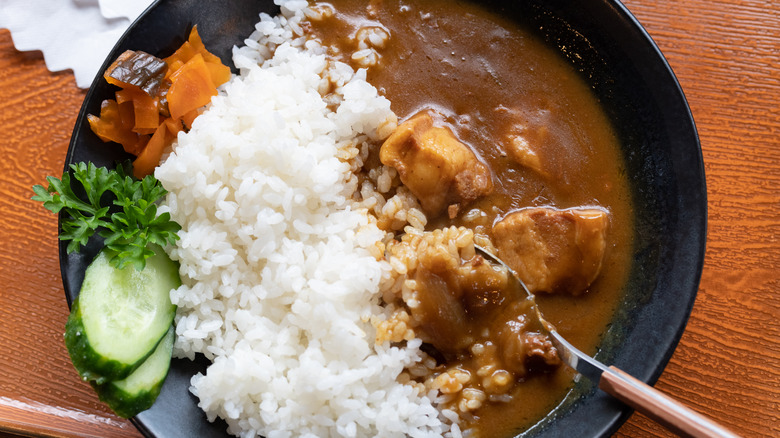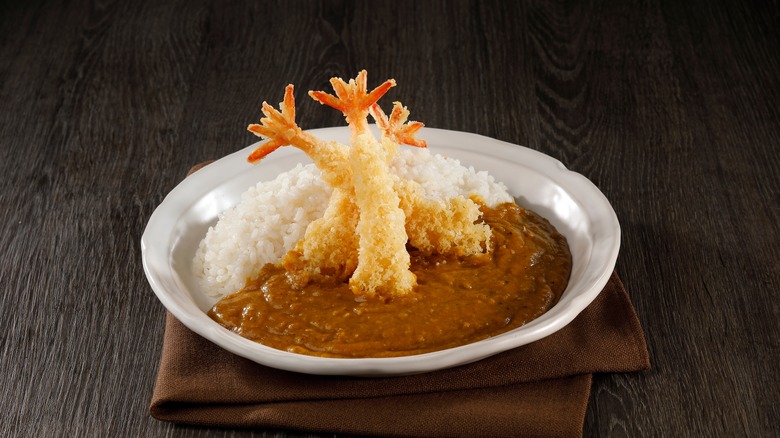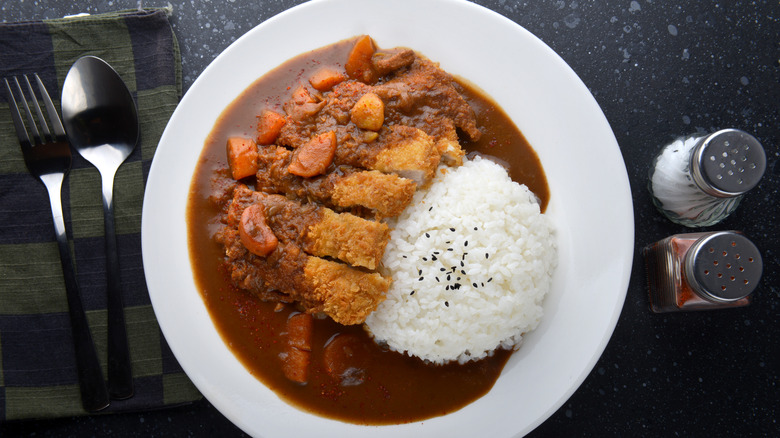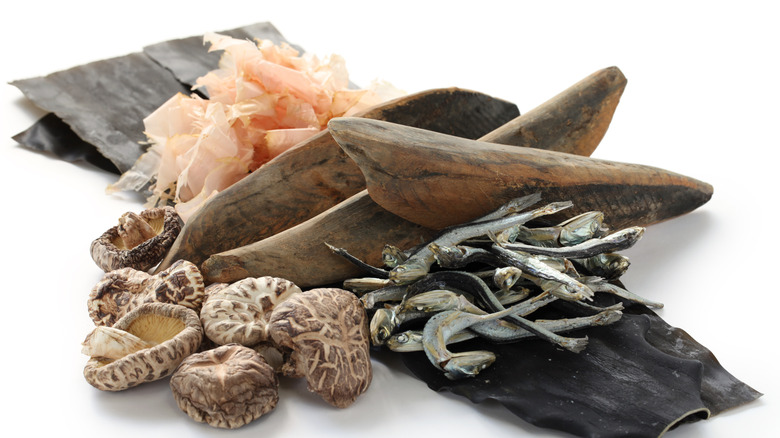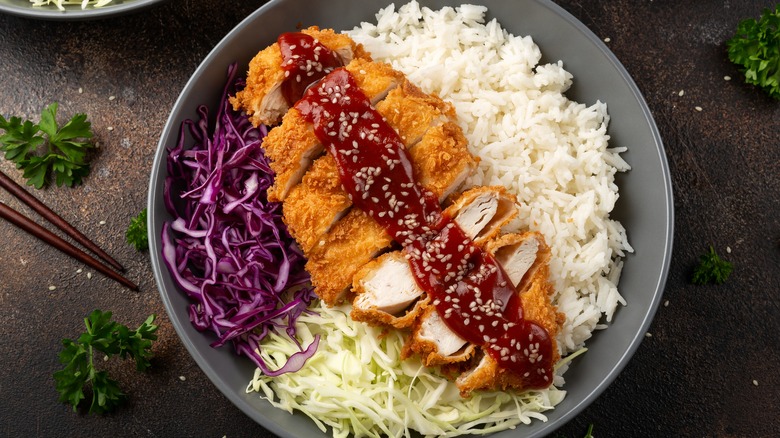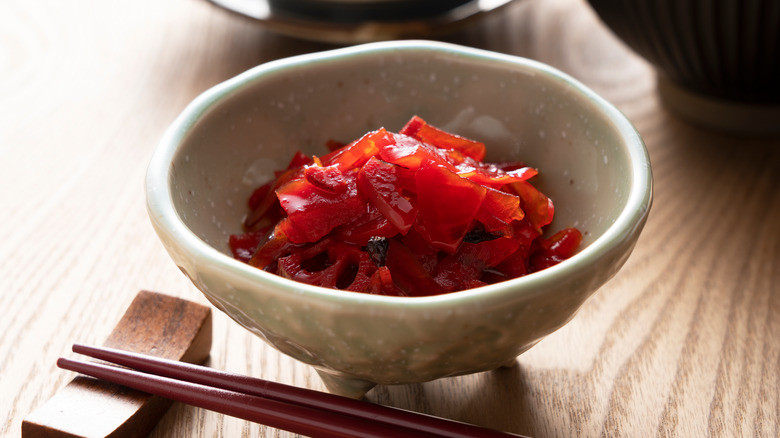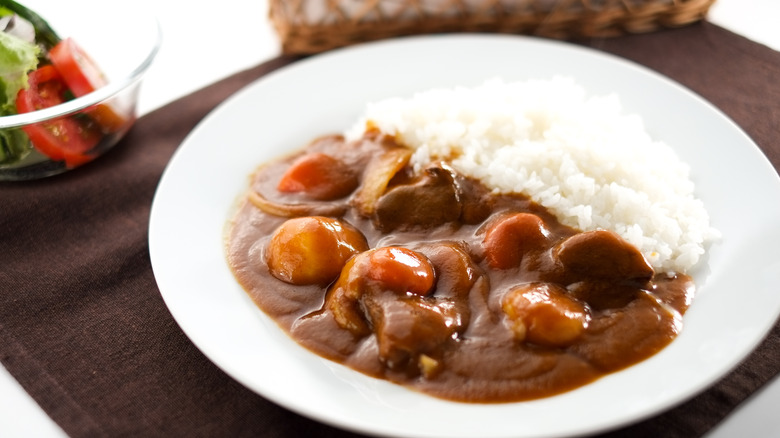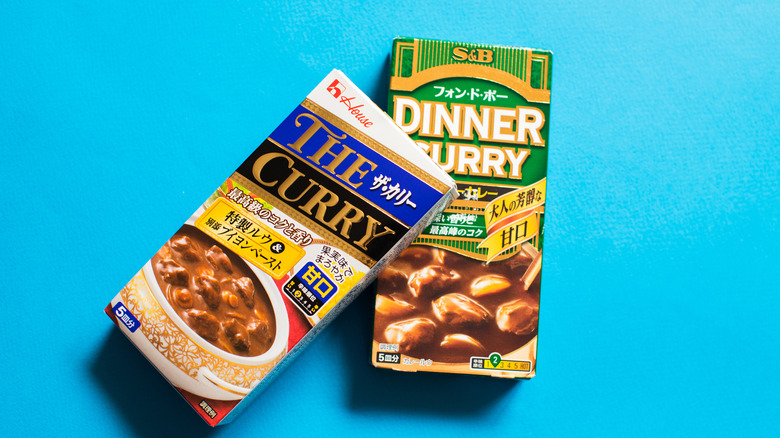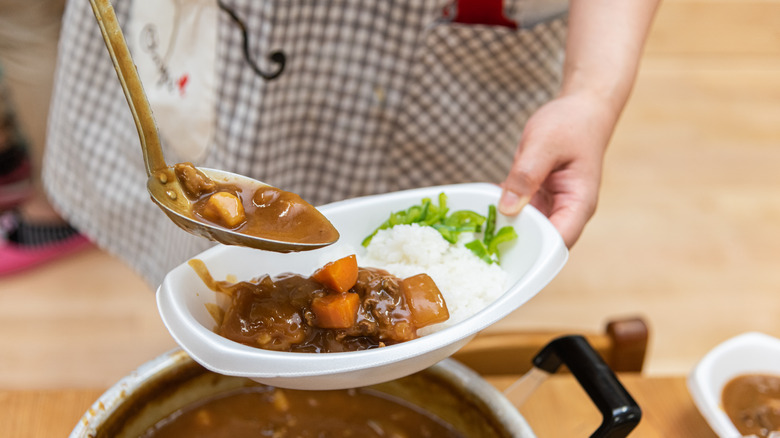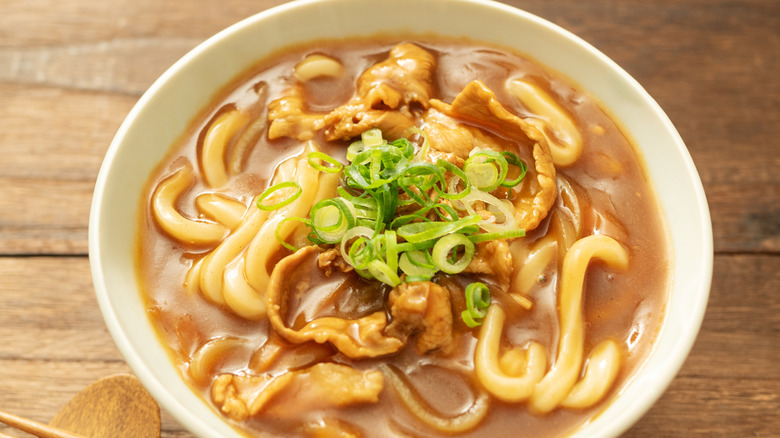The History Of Japanese Curry Rice
Curry rice is the Japanese version of curry. But what exactly is curry? Since the colonization of India, curry has been a widely utilized term, mostly used to describe stews and thick soups that are meant to be eaten with bread or rice.
Today, curries are common all over the world. But what is Japanese curry? Japanese curry is brown, chunky, and thick. Like many of the most delicious comfort foods out there, is not exactly appetizing to describe or look at, but it is delicious. Japanese curry is slightly spiced, often a little bit sweet, and quite thick compared to some of the gravy-based curries you may be used to. It is almost always eaten with rice, but can also be found as a filling in savory doughnuts called kare pan, which translates to curry bread. You can also enjoy curry as a flavoring in many Japanese snacks and side dishes. So while curry's flavor is delectable and beloved, Japanese curry's history is just as intriguing. With a long history that brought it from one corner of the world to another, keep reading to learn more about how this unique food came to combine many cuisines and cultures.
Before curry was known as curry
Before curry came to Japan, it traveled many miles and underwent many transformations. To begin with, we must go all the way back to what is now known as India, specifically during the period when it was under colonial England's rule. When the East India Company was going strong, from the beginning of the 1700s to the end of the 1800s, men would come back from India hankering for what the British called "curry". The name curry is a generalization originally used by Europeans to refer to almost all Indian dishes. The British interpretation of Indian "curries" is incredibly specific, and a dish that the nation soon fell in love with. Since the first curry house opened in London in the early 1800s, the Brit's love of curry has only skyrocketed.
Inspired by the spices of India, specifically turmeric, British curry quickly became a beloved and uniquely Indian-British dish. British curries have changed over time thanks to increased immigration and the diversification of preferences across the U.K. However, there still remain quite a few key differences between Indian and British curries. To start with, India is a huge country filled with countless varieties of curry and gravy-based dishes, while British curry is less diverse since it is based on only a small subset of this sample. British curries tend to be sweeter and thicker, while Indian curries can be tangy, spicy, and smoky.
Curry's introduction to Japan
So now that we know how curry was introduced to the U.K., the question remains, how did it end up in Japan? When you taste British curry, you can begin to understand how Japanese curry rice was born, but how did it physically arrive in Japan? For another quick history lesson, let's go back to the period known as the Meiji restoration, from 1868 to 1912. During the Meiji restoration, the British navy arrived in Japan. While the two countries had been trying to establish a delicate rapport for years once Japan opened its borders, their mutual love of this one dish brought them together. Or at the very least, left a lasting legacy.
This dish was none other than curry. Various stories attempt to explain the moment curry was introduced. One talks of British sailors who arrived in Japan with only curry powder in their possession. Originally adopted by the Japanese Navy as a dish that could be made in bulk, Japanese curry is very different from Indian curry and went through many variations before it reached the place it is today. After that, it was quickly accepted by the general public because it is easy to make in large batches, tastes delicious, and is nutrient rich.
Curry rice in Japan today
Today kare raisu, as it is phonetically known in Japan, is a nationally beloved dish. Even though curry rice has foreign origins, you can find it at almost all train stations, in small hole-in-the-wall restaurants, and in many convenient stores as ready-to-go meals. Curry rice in Japan is made most often using dry roux cubes. We will explain the specifications of Japanese curry rice roux in a moment.
For now, we will focus on what Japanese curry is. It is a thick, brown curry made from curry rice roux cubes that dissolve into water or dashi and make a thick and spiced stew. You can add vegetables like peas, potatoes, and carrots, and meat such as pork or chicken. It is also common to sweeten your curry with shaved apples. The apples make the curry much sweeter than Indian curry, and while the dish remains a very savory meal, it does have notes of sweetness that add to the layers of flavor.
Variations of curry rice across Japan
There are three main types of curry across Japan: spicy, medium, and mild. Beyond these types, there are also regional varieties that can differ in terms of the actual roux base, or in the ingredients that are added to the gravy.
For example, if you go north to Hokkaido, the Northernmost island of Japan, you may be able to find a variety of curry called shika curry. Shika, meaning deer in Japanese, are often used in curry in Hokkaido because there used to be a large abundance of them on the island. Then, if you travel to almost the southern tip of Japan, you can find bitter melon curry in Okinawa. Bitter melon is prized for its health benefits and unique flavor, making it an acquired taste beloved by Okinawa residents. Another interesting curry variety that you can find in Japan is Hiroshima. Hiroshima, which is also famous for its okonomiyaki, is on the ocean and has wonderful oysters. Here, you can find an oyster curry that is made with butter and coconut for added decadence.
This curry is not spicy
Unlike Indian curry which is always spiced, and is also often at least a little bit spicy, Japanese curry is often considered neither very spicy nor spiced. Because most of the flavor in Japanese curry rice comes from the curry roux cubes, the flavor of your final dish is going to depend on which roux you choose. If you pick a mild roux, your curry will be savory and slightly sweet with hints of curry powder, while a spicy one will have a gentle kick at the end of each bite.
Curry powder is an essential ingredient when making your own Japanese curry rice roux, but interestingly enough, curry powder is not just one spice. Curry powder is actually made from a combination of many spices such as turmeric and cumin, and is in no way Indian. Rather, curry powder is a colonial attempt to create a blend that represents Indian curry. On top of that, the name "curry" is a very general term that the British imposed on Indian cuisine to label anything with a sauce or gravy. Therefore, having curry powder as one of the essential ingredients in Japanese curry rice not only exposes its origins but also shows how far removed curry rice is from the origins of curry.
Rather curry rice is very umami
While Japanese curry may not be spicy, it certainly is umami. Umami, the Japanese word for savory, is the fifth taste, along with bitter, sweet, acidic, and sour. If you can find a dish that combines all of these components, then your taste buds will thank you. The balance that comes from a dish that has undertones of bitterness, a splash of acid, and lingering umami is undeniably satisfying and inexplicably easy to devour. You can achieve umami flavors in many ways, but one of the most classic ways to bring umami to your Japanese dishes is by using dashi.
To make your Japanese curry truly outstanding, make sure to add dashi to the final stew. This small addition will bring a much-loved depth of umami to your curry. Dashi, which is a Japanese soup base or broth, is usually made with three to four staple ingredients. To make truly delicious dashi, you should make sure to add katsuobushi, which is fermented and dried skipjack tuna, shiitake mushrooms, and kombu. These three items, which are high in umami alone, come together and create an umami wonderland when combined.
Enjoy tonkatsu with your curry rice
An essential marriage that you must invite yourself to is the marriage between curry and rice. Hence, the name curry rice. A perfect spoonful of curry and rice together is bliss. The thick creaminess of the curry with a starchy, satisfying bite of rice, comes together to make the most comforting meal you can imagine. If you think that it is nearly perfect, wait till you try curry rice with a piece of tonkatsu.
If you want to step up your curry game, hold on just a second. A common addition to curry rice is tonkatsu. Tonkatsu is breaded and fried pork cutlet that has been pounded into a thin slab. These pieces of pork are often smothered in a sauce that somewhat resembles Worcestershire sauce and then eaten when they are still crunchy and warm. You can find tonkatsu in sandwiches, at street food stalls, and best of all, on top of your curry rice. The additional crunch from the fried tonkatsu makes all the difference in a bowl of curry. It brings a wonderful texture as well as some chew and heartiness. If you are not a meat or pork eater, you can also enjoy potato croquettes or breaded vegetables as alternative fried treats.
Pickle me please
We did just say that the last thing you need to complete the ultimate curry rice is tonkatsu, but perhaps we stand corrected. One final addition to your bowl of curry comes in the form of small, square pickles that are often bright red when you buy them in the store. These pickles, named fukujinzuke, are made from a variety of vegetables with the most common being daikon, eggplant, and cucumber. Adding a portion of fukujinzuke to your curry will bring a zing of acidity and brightness to each bite and truly be the final touch that balances this delicious meal.
If you choose to make your own fukujinzuke, your pickles will probably not turn out bright red. That is, of course, if you choose to not use a food dye. If you do leave the pickles their natural color, you will be left with some unappealing brown-looking pickles that may not look so great but certainly taste delicious. You will love the savory, sweet, and salty combination that blossoms from the fukujinzuke pickling liquid which is made from soy sauce, mirin, and kombu. And you will probably be so in love with these pickles that you will start to eat them with everything, not just your curry rice.
Don't forget about texture
As we mentioned, you can make curry with a variety of ingredients, and the base of your curry is so important. While chicken, potatoes, and carrots are among the most classic, this dish is amenable to almost anything. With any dish, it is important to think about texture. While curry rice is inherently a stew-based dish that tends to be on the softer side, it is still nice to have a chewy, crunchy, or soft bit every once in a while. You can get this from both the fukujinzuke and tonkatsu, but you can also elevate your texture game by adding specific ingredients to the curry itself.
If you are looking for a dish that is a little bit more hearty, then try adding in some proteins like chicken, pork, or beans, making it perfect for a winter evening. If you want something more vegetable-forward, curry is a great way to get rid of many old veggies. You can dump in carrots, onions, greens, and even broccoli if you are looking for some added greenery.
Make curry with a cube
Curry is made with curry roux, and while you can make your own curry roux at home, most people buy curry roux cubes from the store. These cubes come packaged sort of like bouillon cubes and are a great pantry item to have on hand any time you are craving curry. To use them, you can simply make a broth and then dissolve the curry roux into the liquid until it is fully incorporated and the curry begins to thicken. If you are adding in meat, make sure to cook it separately so that the liquid does not disrupt your curry's consistency.
While using store-bought curry roux cubes is a very viable option, some people may choose to make their own curry roux. To do so takes much more time and is a fairly involved process, but it is worth the effort. The benefits of making your own roux mean that you can control the spiciness and flavors of your curry, truly tailoring it to your taste. Most curry roux are made with butter, flour, spices, and some chili or cayenne pepper. These ingredients come together in a roux that can then be packed into individual shapes and stored until ready to use.
This is the best meal for a cold evening
If you are looking for a warming meal, then curry rice is your one-stop shop. This meal, which is both satisfying and comforting, is perfect for a chilly evening. The thickness of the curry sauce goes very well with rice, and the heartiness bought by any additional vegetables will leave your belly feeling happy and full.
Throughout the year, not only in the winter, you can find large vats of curry simmering away in houses and along the streets of Japan. Many people love to have curry as a weeknight meal because it is easy to whip up and a very filling and nutritious option. Also, because curry is so versatile, you can never get bored. If one night you have curry with tonkatsu, why not have it with peas and potatoes the next night, and with fukujinzuke the night after? Curry will make anyone feel cozy and ready for a night in. If you do make a big batch of curry, also keep in mind that you can freeze it. Curry rice freezes very well, and if you portion out individual meals for yourself, you will always be ready with a meal.
Udon with curry is a good alternative
Perhaps you are an avid curry fan and have already exhausted all of the curry rice combo options. Well, do not fear. There is a fantastic alternative out there available for you, and it is curry udon. Curry udon, which is exactly what it sounds like, is a great curry alternative that is just as satisfying but with all of the chew from udon.
Udon noodles, which are Japanese wheat noodles, are thick, chewy, and possibly more satisfying than rice (in our opinion). To make curry udon, the only change you need to make to your recipe is adding in more liquid. This makes a slightly thinner curry sauce which is perfect for your udon noodles. Rather than having a dollop of curry on top of the noodles and making more of a noodle stir fry, the thin curry creates a hybrid between a broth and a sauce. This sauce is just thin enough to be used as a broth for your udon, and just thick enough to coat each noodle perfectly before it is devoured.
Static Media owns and operates Tasting Table and Mashed.
